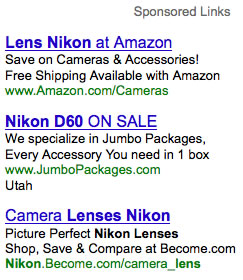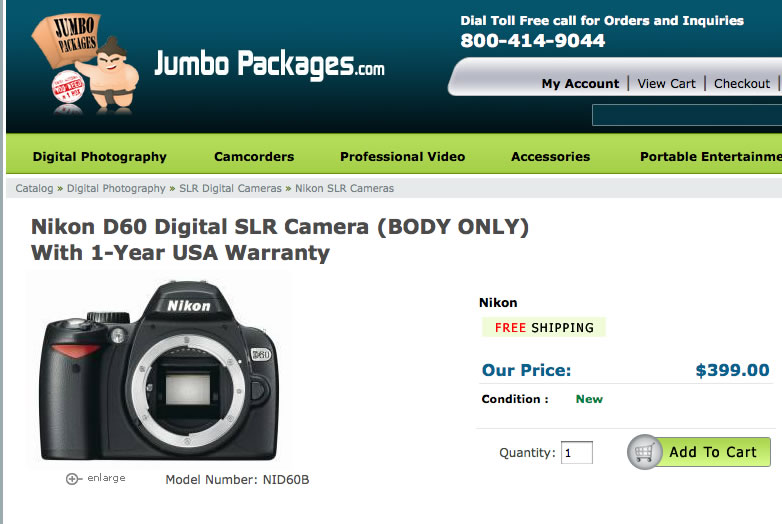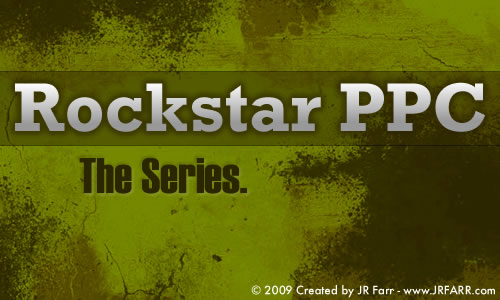Today I want to talk about writing compelling ad copy that will not only increase your CTR% (click through rate) but also lift your overall conversion rate. It’s easy to blame a poor conversion rate on your landing page but when your paid search campaigns aren’t “top notch”, that could be where the bottleneck is happening.
Obviously your shooting to have your ad copy “catch” the users attention BUT remember to also keep that compelling component go all the way through to the landing page.
C’mon, let me show you what I’m talking about.
Starting Point – The Ad
Let’s say for example I’m looking to purchase a new SLR camera lens for my Nikon D60. So I head over to Google and search for “Nikon D60 Lenses”. Seems like a logical keyword phrase to search right?
Well maybe… here are the top 3 results:

TIP: Out of the top 3 results, none of them are geared specifically for my keyword phrase.
I clicked on the 2nd ad and was directed to this landing page.
No way — Are you serious? Was my search that specific that you couldn’t point me in the right direction?
First of all with these being the top 3 results I was hoping for a little more specific ad copy. Gee I don’t know, how about a more targeted ad like this:
Nikon D60 Lenses (Solid keyword headline)
Wide Selection of Nikon Lenses. (A feature or benefit when visiting our website.)
Buy Today & Get Free Shipping! (Call to Action)
DigitalCameraInfo.com/Nikon-Lenses (Reinforcing the category or product once more.)
Dude Where’s my Car? errr… My Lens?
Sure out of the 3 ads, we’d expect that Amazon would take me to the right place but what’s with that ad copy? “Lens Nikon at Amazon“. What does that even mean? No, just because you put your brand name in your headline doesn’t mean I’m going to click on your ad. Sorry, but you have to try harder than that.
After clicking on the 2nd ad, I was not directed to the Nikon Lens page. This immediately made me want to click the back button.Why make the user dig through your site to find what they’re looking for?
Now, we’ll go into this later but the reason this ad was displayed when I searched this is because he’s buying the term Nikon D60 as a “broad match” term.
Broad Matching Terms: Allows your ad to show on similar phrases and relevant variations
This mistake goes back to my last article about the importance of paid search account structure. When you create tightly, crafted campaigns with 10-15 keywords you can avoid this costly mistake.
Wrap it Up with Common Sense
Do you necessarily need to make a Nikon D60 Lens ad group & a Nikon D40 Lens Campaign and so on? No, but if you want a better CTR and maximize your money, do it the right way and stop being lazy. If you’re not taking the time to setup these campaigns very specific, then you’re just throwing your money away.
Lastly, keep in mind that it’s not just your ad copy that’s saying something to your users… You’re landing page is part of the “pre-sale” process as well. Ensuring that your ad copy and landing page copy all mesh well together is key. My point to all of this is to make it easy, precise and to the point 😉
Now go make sure you’re ad copy makes sense from start to finish.
Was this helpful? Let me know if I didn’t touch on something or you need more clarification. In the meantime be sure to Subscribe to my RSS Feed or Follow @jrfarr on Twitter for the next Rockstar PPC installment.






